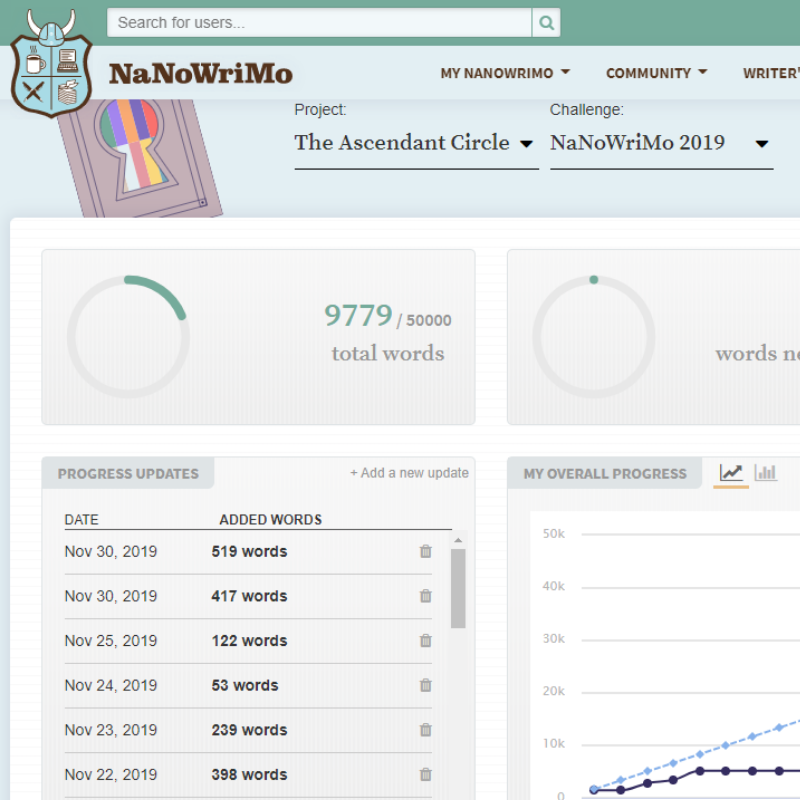
Once again, I entered November with the best of intentions, and did not come close to the traditional 50,000 word goal of National Novel Writing Month. I did create a new story with an outline, characters, and over 9000 words, and I learned a few things as well.
From my time in the military, I learned the practice of the After Action Review (AAR). After a training exercise and such, a squad would do an AAR to compare what was planned to what actually happened. A common way to organize this was “three ups, three downs” – share three things that worked, and three things that we should never do again. So this is my three-ups, three-downs for my NaNoWriMo experience.
UP: Learned to realistically calculate a daily word goal. I used a planning method from Sarra Cannon of SarraCannon.com. Take a calendar, mark off the days I know I won’t be writing (e.g. Thanksgiving Day) and then mark off a couple more that I might use to catch up if/when I fall behind. Then divide my monthly word goal by the number of remaining days, and presto, there’s my daily word count. This gave me an accurate target, while also scheduling in some flexibility.
This works well for scheduling anything that requires multiple days of effort to accomplish a single task, and I’ll be using this method again.
UP: Learned about a new app, Novlr.org. It’s a web-based app that helped me focus on my words, organize notes and scenes, and allowed me to work from any computer with internet connection. They have a free trial period and there was a discount code on the NaNoWriMo.org website for a limited time. It was useful for me because my usual writing app, Scrivener, is only installed on my laptop and I spent most of NaNoWriMo writing on my desktop PC. Its export isn’t that great (only to PDF), so we’ll see if I continue to use it.
UP: Learned to quick-plot a novel. Since NaNoWriMo is all about the fast-and-ugly first draft, any plot structure will suffice for me, really, so I just picked one. I filled in the particulars of my story and characters, and built a scene list. From there, I could concentrate on one scene at a time. Breaking a large task into smaller bites is always the best idea when possible, and quick plotting gave me enough structure to start writing, and keep writing.
DOWN: Overestimated my ability to write faster. I’ve been tracking my writing time and words for years now, so I know that my typical speed is around 600 words / hour. If I was honest with myself, I would have pushed to get in the four to five hours per day I needed. Instead, I lied to myself, saying “Oh, we’ll just put in a really full day on the weekend and catch up” or “I can totally crank out a thousand words per hour.” Yeah, no.
DOWN: Failed to complete tasks in September and October, which left me stressed in November. Lots of other priorities needed to be done before the end of the year, and some of those had to be done in November because they didn’t get done before.
DOWN: My (self-inflicted) limitations kept me from putting in the butt-in-chair time.
When a task is important, I often retreat, in hopes of letting someone else do it, since I’ll just screw it up. That worked when I was a child — I’d quit, hide in my room, and let the adults step in. As an adult now, I fulfill priorities that other people place on me, When it comes to my own priorities, though, I often let things slide. I’m more aware of this now. Going forward, I need to drag that inner child out of his room and set him to work to make my dreams a reality.
I don’t know if I’ll do another NaNoWriMo. I will keep working on my stories; I’ll keep working on my craft and my productivity. I’m certainly grateful for the valuable lessons I learned this year. We’ll see what happens when November rolls around again next year.
One last UP: Learned how fortunate I am. I received a lot of support from the Instagram and Twitter communities, as well as friends and family. Though I didn’t win NaNoWriMo, I am so grateful for the people who were rooting for me. Thank you for joining me on this journey.
Leave a Reply